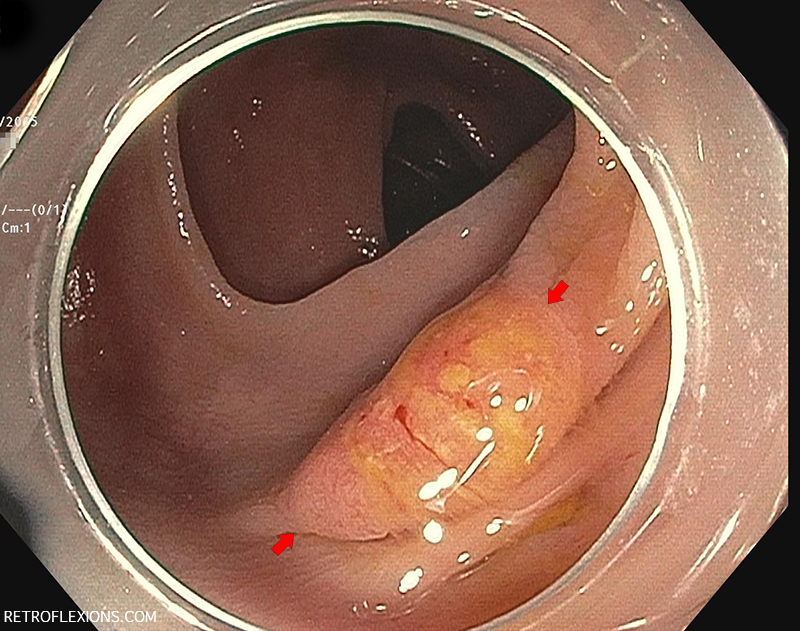Remember this picture? This was the small flat polyp found incidentally on colonoscopy that I wrote about recently [see: Flat “polyp” resection (part one)]. This lesion was removed using standard endoscopic mucosal resection technique and came out nicely in one piece.
I was surprised when the pathologist called me a few days later about the patient, since pathologists usually only call when a result is malignant or unusual. This “polyp” which I estimated to be about 12-mm in greatest diameter, was a serrated adenoma (not a surprise) but also contained an 8-mm focus of invasive adenocarcinoma. Luckily, the carcinoma portion of the polyp was completely resected with clear margins on all sides, however this polyp was truly an early-stage colon cancer!
Just last month, there was an article in The American Journal of Gastroenterology focusing on the problem of interval colon cancer. Interval cancers are cancers that arise within the suggested surveillance period for colonoscopy; e.g., if a patient has a colonoscopy and is told to come back in 5 years for a repeat exam, yet he develops colon cancer in 2 years, that is an interval cancer. Interval cancers are either missed lesions during the prior colonoscopy, or incompletely resected lesions, or new lesions.
In the above case, this patient had a colonoscopy just 2 years prior by another gastroenterologist…therefore, this represents an interval cancer. This lesion has all the high-risk features of an interval cancer, since it arose from a flat polyp in the right-side of the colon. These flat polyps are the easiest to miss, often happen in poorly cleaned segments of bowel, are harder to completely resect, and are biologically different in the way they transform into cancer from other types of colon polyps. In fact, flat lesions such as the one above are five times more likely to be missed on colonoscopy when compared to pedunculated polyps (polyps on a stalk).
There are further management issues about this lesion that are beyond the scope of this article regarding surveillance of this lesion, need for surgery vs. repeat endoscopic inspection, etc. But I would like to bring up one general point about lesions like this: One should always consider marking the site of a “funny-looking” polyp with a tattoo, just in case you need to go back in the future to re-examine the site, or if a surgeon will need to find the site later to operate. Luckily, since this polyp looked a little ulcerated, I obeyed my own rule and placed a small endoscopic tattoo near the site to facilitate finding the exact spot in the future.
Click here for the final part of this article to see what happened to this lesion.
If you enjoyed this article, sign up for our free newsletter and never miss a post!
Reference:
Adler J and Robertson DJ. Interval colorectal cancer after colonoscopy: exploring explanations and solutions. Am J Gastroenterol 2015;110:1657-1664.
